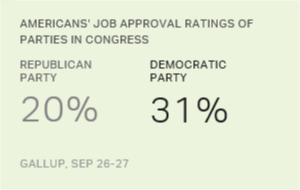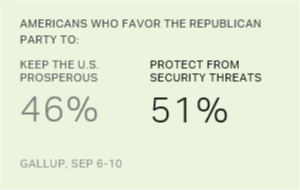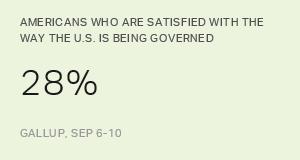Story Highlights
- Democrats hold 44% to 37% advantage in party identification and leaning
- Have led by five to nine percentage points throughout 2017
WASHINGTON, D.C. -- Forty-four percent of U.S. adults identify as Democrats or are independents who lean to the Democratic Party, while 37% are Republican identifiers or leaners. Democrats have maintained an edge of between five and nine percentage points on this measure of party affiliation throughout 2017, after holding a narrow advantage in late 2016.
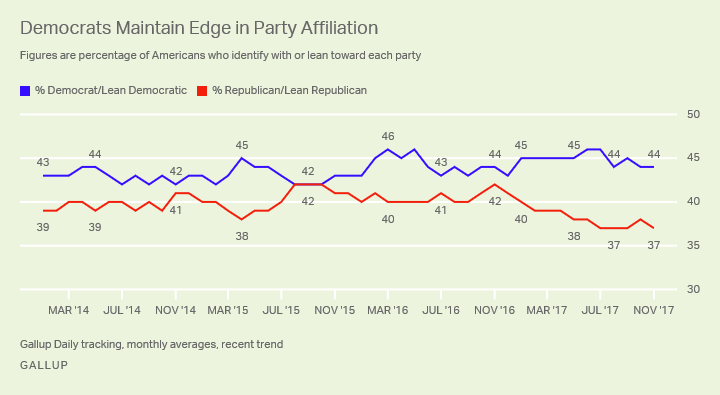
The latest figures, from Gallup Daily tracking interviewing throughout November, are based on interviews with more than 14,000 U.S. adults.
Democrats' edge has expanded this year mainly because of a decline in Republican affiliation. A year ago, 44% of Americans identified as Democrats or leaned Democratic, the same percentage as now. However, Republican identification and leaning is five points lower than it was a year ago. More Americans now say they are nonleaning independents (14%) or do not have an opinion (5%) than did so in November 2016 (10% and 4%, respectively).
Republicans have had worse showings than their current 37% in Gallup's tracking trend, which began in January 2008. In December 2008, shortly after voters elected Barack Obama to replace George W. Bush as president in the midst of the Great Recession, only 34% of U.S. adults identified as Republicans or leaned Republican. In that month, 53% of adults were Democratic identifiers or leaners, tied for the highest in Gallup's tracking trend.
Over the last 10 years, Democrats have yet to trail Republicans in any month. At best, Republicans have tied Democrats, as they did in August 2010 and August and September 2015.
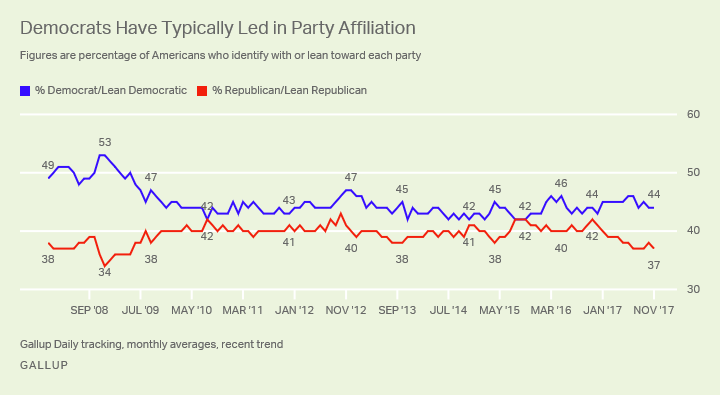
From a longer-term perspective, using annual data from Gallup nontracking polls that go back to the early 1990s, Democrats have averaged a five-point advantage over Republicans in party affiliation, with leads in all but four years.
Implications
Fewer Americans identify as Republicans or say they are Republican-leaning independents than did so in November 2016, the month Donald Trump was elected president. Meanwhile, Democratic identification and leaning is the same as a year ago, with more Americans not leaning in either political direction. These changes have left the Democratic Party in a stronger position now versus the GOP, but not because the Democratic base has increased.
The parties' relative strength will be tested next year during the midterm elections as Democrats attempt to win control of one or both houses of Congress. A shift in party control of Congress is more likely to occur when an unpopular president is in the White House. Unless Trump's approval rating improves significantly over the next 10 months, he will rank among the least popular presidents at the time of a midterm election.
The challenge for the GOP, then, is to convince its increasingly smaller base of voters -- most of whom approve of the job Trump is doing -- to turn out. Also, Republicans will need to persuade unaffiliated Americans, many of whom may have leaned Republican in the recent past, that Republican candidates and policies offer a better choice for their district, state and country than Democratic candidates and policies.
Survey Methods
Results for this Gallup poll are based on telephone interviews conducted Nov. 1-30, 2017, on the Gallup U.S. Daily survey, with a random sample of 14,714 adults, aged 18 and older, living in all 50 U.S. states and the District of Columbia. For results based on the total sample of national adults, the margin of sampling error is ±1 percentage point at the 95% confidence level. All reported margins of sampling error include computed design effects for weighting.
Each sample of national adults includes a minimum quota of 70% cellphone respondents and 30% landline respondents, with additional minimum quotas by time zone within region. Landline and cellular telephone numbers are selected using random-digit-dial methods.
Learn more about how the Gallup U.S. Daily works.


